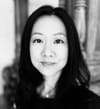

In the 1840s and ‘50s, restless young men – yuppies of their day – were organizing “base ball” clubs to bond and exercise in New York City. Such were the beginnings of America’s new national game. However, baseball, New York-style, wasn’t only the preserve of well-to-do white guys. To many, Black baseball means the Negro Leagues, the vibrant, self-reliant enterprise founded in 1920 in response to Jim Crow-era prejudices (and only recently historically validated by major-league baseball). But in the 19th century, with baseball no different than the society it was embedded in, African-Americans formed their own amateur and professional teams.
Uncover the history of Black baseball in NYC and the sites where it was made in our upcoming talk with baseball historian Dave Kaplan! Tickets for this live virtual talk are just $10!
In 1867, the National Association of Base Ball Players – baseball’s first organized league – barred teams with Black players. Less than 10 years later, the new National League adopted an unofficial ban that would endure nearly 60 years. Black baseball became a unique part of American culture, and in New York City, it’s become a long-lost history. From its beginning in the settlement of Weeksville to the stadiums of the Negro Leagues, discover long gone and still extant New York City locations connected to the history of Black baseball!
1. Weeksville, Brooklyn

In Brooklyn, a city of its own by mid-century, baseball fever extended to one of the country’s largest free African-American communities (slavery was outlawed in New York in 1827). Black laborers and tradesmen in Weeksville, a north-central Brooklyn settlement, now Bedford-Stuyvesant, founded by freed slaves, formed a club called the Unknown. In 1859, the Unknown challenged the Henson Base Ball Club of Jamaica, Queens in the first documented game between all-African-American baseball teams.
2. Satellite Ground, Williamsburg, Brooklyn
The Satellite Ground at Union and Montrose Avenues opened in the 1860s and served as a ballplaying venue for early Brooklyn teams such as the Fultons. It was also the seat of early Black baseball – the home ground for the Unknown of Weeksville, the Uniques and the Monitor and site of the “championship of colored clubs” in 1867. Situated across the street from the Union Grounds – the first enclosed baseball field ever constructed – the Satellite (like the Union and Capitoline Grounds in Bedford-Stuyvesant) hosted cricket and ice skating as well. Each was flooded in the winter to form a giant skating rink – where baseball was also played on ice! The NYPD’s 90th Precinct house now occupies the Satellite Ground site.
Two years after the Civil War, “The First Colored Baseball Championship,” held at the Satellite Ground in Williamsburg (near the Greenpoint border), generated considerable interest. The city’s daily newspapers covered the tournament between the Monitors and Uniques, both Brooklyn clubs, and the Excelsior of Philadelphia, noting the large crowd, many of which were white males. Wrote the Brooklyn Daily Union, “… a large number of the demoiselles of darkydom … (who) … by their expressive and readily distinguishable smiles, cheered the dusky heroes in their noble endeavors.”
[post_featured_tour]
Segregation didn’t quite prevent contact between Black and white players. They played together during the Civil War, and nearly 70 African-American players played in the minors – until an unwritten rule in the late 1880s prohibited the use of “colored” players. Shut out from the white man’s game, Black players organized barnstorming teams, none more skilled than the Cuban Giants, baseball’s first salaried African-American team, founded in 1885 by a Babylon, New York hotel worker.
The players spoke with a mock Spanish accent to reduce any racial tensions. They took on all comers – college, semi-pro, and white teams, including the major-league Metropolitans at the first Polo Grounds. The first Polo Grounds was the first commercial ballpark in Manhattan located opposite Central Park on 110th Street. In business until 1915, the Cuban Giants were a pre-Negro league powerhouse. Their rivalry with the New York Gorhams, named after a Black tavern owner on Thompson Street in the Village, even included raiding each team’s stars.

Frant Grant, bottom row second from the right, Image via Wikipedia
One of those stars was Frank Grant, considered the greatest African-American player of the 19th-century. Grant played for both the Gorhams and Cuban Giants. Sadly, Grant lived out his post-playing days in obscurity. He worked as a waiter and porter and lived on Minetta Lane, part of the Village called “Little Africa” for the many African-Africans who lived there. Grant was enshrined in the Baseball Hall of Fame in 2006, almost 70 years after he died.
3. Ridgewood Park, Ridgewood, Queens
Built in 1880s on the Brooklyn/Queens border, the park was a popular site for professional Brooklyn teams who benefited from loose enforcement of blue laws prohibiting Sunday baseball. Pre-Negro league teams like the Cuban Genuine Giants played here in the 1890s. The field was later home for the New York Royal Giants (1912). The park was modified for various uses through the years and demolished for commercial industrialization in 1959.
4. Dexter Park, Woodhaven, Queens

Originally a racetrack, the 15,000-seat Dexter Park hosted a myriad of athletic contests, from semi-pro baseball games to rodeos, boxing matches, and more from 1889 through 1956. Located on Jamaica Ave. and 76th Street near the Brooklyn/Queens border, the park was the longtime home of the semi-pro Bushwicks, a white team who regularly took on barnstorming Black and Negro league teams. It was also home to the Eastern Colored League’s Brooklyn Royal Giants in the 1920s. Dexter was demolished in 1956 for housing construction.
5. Olympic Field, Harlem
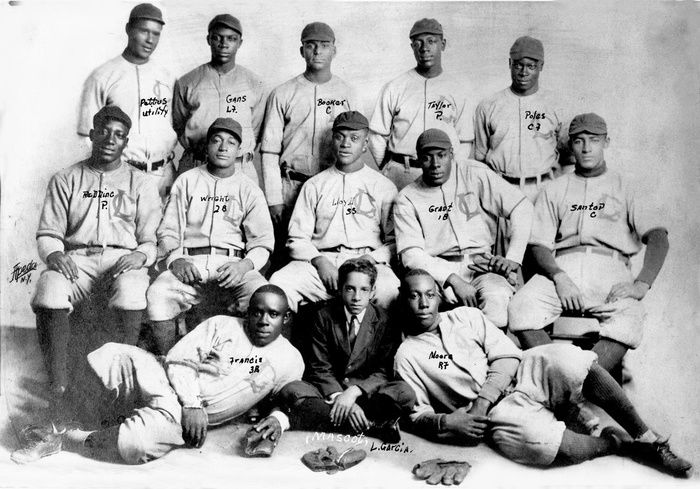
The New York Lincoln Giants, Image via Wikipedia
By 1920, the Great Migration, with the promise of a freer and better life for Southern Blacks, increased New York’s African-American population to 154,000. Baseball was finding its own important niche in Black communities. Despite prevailing prejudices, amplified by the overtly racist 1915 film “Birth of a Nation,” African-American teams fostered high-level competition. In New York, the Lincoln Giants (1911-30), became a barnstorming juggernaut, going 108-12 their first season. They featured pitching legend Smokey Joe Williams and shortstop John Henry (Pop) Lloyd, who Babe Ruth believed was the greatest player who ever lived. Alas, there was no house that Pop built; the Lincoln Giants mostly played home games at Olympic Field in Harlem between 1911 and 1919.
Olympic Field opened in 1904 in the middle of Harlem at East 136th and Fifth Ave. Enthusiastic crowds in the thousands, often significantly white, watched the Lincoln Giants take on challengers there, from semi-pro teams to major-leaguers. They developed a fierce rivalry with the Brooklyn Eagle Giants for the “Colored Championship of Greater New York.” When the field was razed for a parking garage in 1920, the grandstands were relocated to the Catholic Protectory Oval, the Lincoln Giants’ new home.
6. Catholic Protectory Oval, Parkchester, Bronx

East Side, West Side: Tales of New York Sporting Life, 1910-1960
Situated on the 150-acre grounds of an orphanage in the Parkchester section of the Bronx on East Tremont Ave. and Unionport Road, the Oval was home turf for the New York Lincoln Giants. The Giants had relocated from Harlem where they played over the previous ten years from 1920 to 30. Other semi-pro and Negro league teams played at the Oval before the Catholic Protectory was leveled in 1938. The Met Life Insurance Company developed the site for the Parkchester, then the world’s largest apartment house community.
7. Dyckman Oval
In the 1930s, some Negro League owners, for want of legitimate stewardship, became numbers racketeers. They were men with money, expected to support the Black community, the most influential being Alex Pompez, a dapper Afro-Cuban-American and longtime owner of the successful New York Cuban Stars and reorganized New York Cubans.
Pompez, who lived at 409 Edgecombe Ave. on Harlem’s Sugar Hill, was a high roller and briefly a lieutenant in famed mobster Dutch Schultz’s numbers operations. His baseball entrepreneurship was momentous. For one, he internationalized the Negro leagues, importing top Latin American talent. He also operated and installed lights at the Cuban Stars’ home – the Dyckman Oval in the Inwood section of Manhattan, a leading Negro league and semi-pro ballpark in the 1920s and ‘30s.
Ultimately, Dyckman Oval was razed in 1938 for the Dyckman Houses, a group of apartment buildings. Pompez’s work in baseball, however, was far from done. He helped pioneer a growing influx of Latin players into the majors while working for the New York and San Francisco Giants (1952-70).
8. Ebbets Field (Brooklyn Dodgers 1913-57)
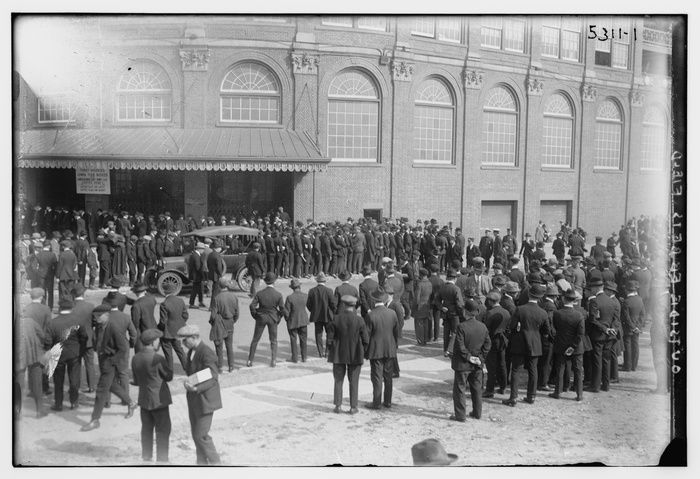
Image via Library of Congress
On occasion, New York City’s three major-league teams hosted Black and Negro league teams at their ballparks. In 1919, the Bacharach Giants, a powerful Black team based in Atlantic City, played a five-game series against white all-stars – the first time Black men played at Ebbets Field. Ebbets also hosted the 1935 Brooklyn Eagles, who moved to Newark the following season under the ownership of Abe and Effa Manley.
9. Polo Grounds (New York Giants 1891-1958)
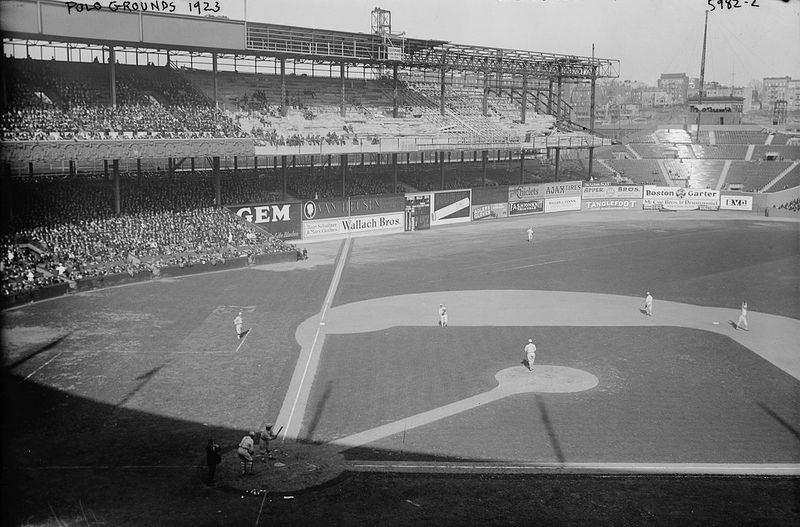
Polo Grounds in 1923. Image via Library of Congress Prints and Photographs Division
A frequent home of New York Cubans (1935-50) and other Negro League games during the league’s 1940s heyday. The Polo Grounds, with its iconic horseshoe contours on Coogan’s Bluff in upper Manhattan, also hosted av1947 Negro All-Star game (East-West Classic) drawing 42,000 fans. The first Polo Grounds at 110th St. and Fifth Avenue hosted Cuban Giants games in the 1880s.
10. Yankee Stadium (New York Yankees 1923-2009)

Image via Library of Congress
The New York Lincoln Giants would disband in 1930, but not before making history. On July 5, 1930, they played the Baltimore Black Sox in a doubleheader at Yankee Stadium – the first Black teams to do so – as a benefit for the Brotherhood of Sleeping Car Porters, the nation’s first successful Black union. The games attracted 20,000 fans, and the moneymaking potential of Black baseball wasn’t lost on Yankee owner Jacob Ruppert.
Black baseball had become more organized in 1920 with Rube Foster’s founding of the Negro National League featuring Midwest-based strongholds such as the Kansas City Monarchs. Negro League teams, which traveled by rickety buses playing 200 games a year, including winter exhibitions, gained larger revenues and exposure in major-league stadiums. The Polo Grounds and Yankee Stadium – both close to Harlem – hosted many Negro League games, the rentals totaling $100,000 a year for the Yankees. Fans came to see stars such as Satchel Paige and Josh Gibson – the most prodigious power hitter in the history of Black baseball – who reportedly hit the only home run completely out of the Stadium during a 1934 doubleheader.
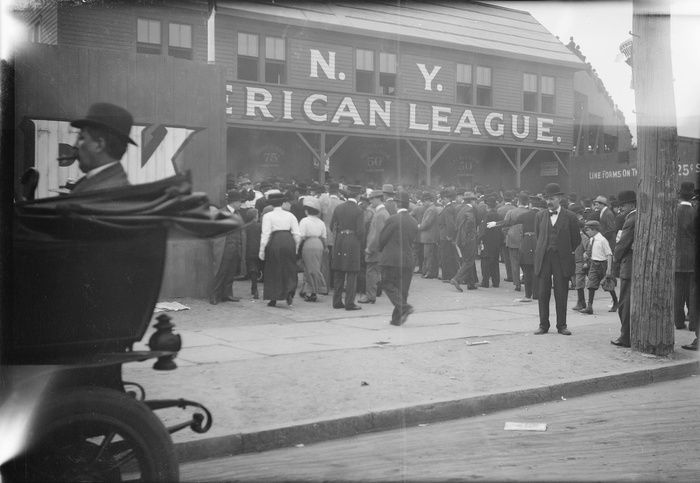
Hilltop Park in Washington Heights, former home of the Yankees, Image via Wikimedia Commons
Ted Radcliffe, who played for thirty Negro league teams in thirty-six years, impressed famed New York newspaperman Damon Runyan when he performed as a catcher and pitcher in successive games of a 1932 Negro Leagues World Series doubleheader at the Stadium. Runyon called Radcliffe “Double Duty” and the name stuck until Radcliffe’s death at 103.
From 1930, when a Negro league doubleheader was held to benefit the Brotherhood of Sleeping Car Porters, to 1948, some 225 Negro league games were played at the original Yankee Stadium. Also included are three Negro League All-Star games (East-West Classics) – 1948, 1958 and 1961. The Stadium often hosted the New York Black Yankees, primarily from 1941-47, and the team’s earlier incarnation, the Harlem Black Bombers in 1931.
By 1947, of course, Jackie Robinson broke baseball’s longstanding color barrier. Fellow Negro league stars like Willie Mays and Hank Aaron would follow. The unique spectacle of Black baseball would disappear.
Keep exploring the baseball history of NYC on our upcoming virtual talk with baseball historian Dave Kaplan! Tickets to this virtual talk on Tuesday, February 23rd are just $10! You can also gain access to unlimited free virtual events per month and unlock a video archive of past events as an Untapped New York Insider starting at $10/month.
Already an Insider? Register here!
Next, check out The Lost Sport of Ice Baseball That Originated in Brooklyn and 8 of NYC’s Lost Baseball Stadiums


